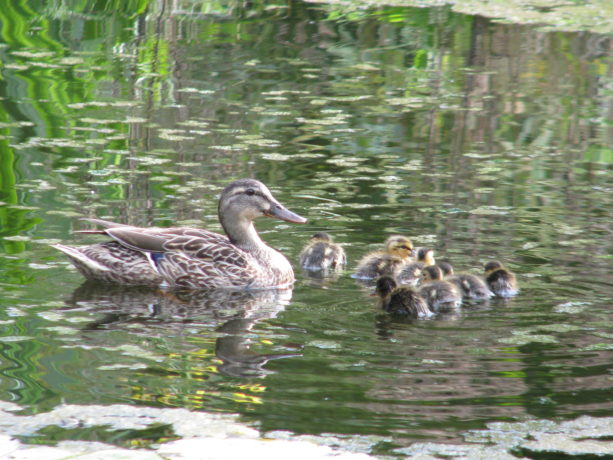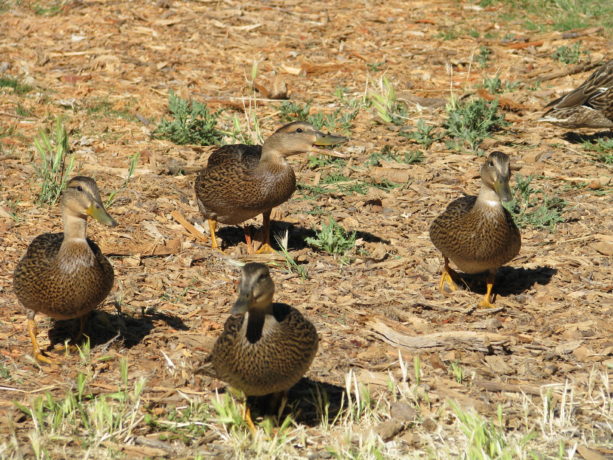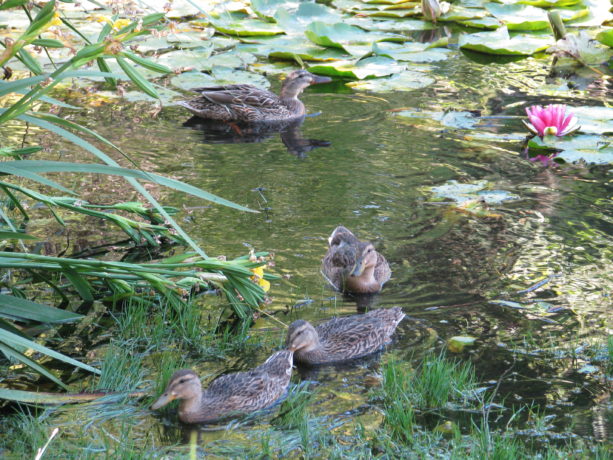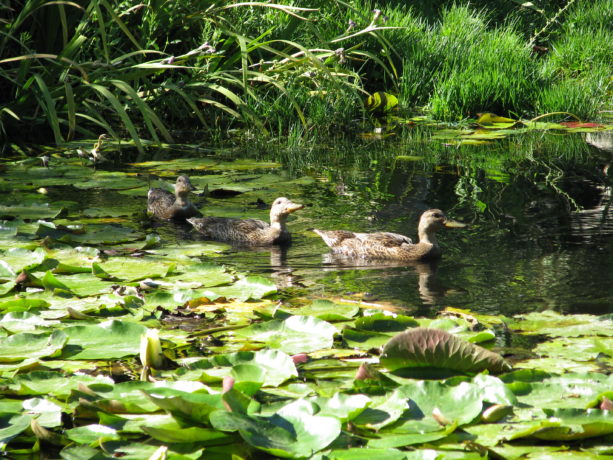Mallards in May
 Every year our two wild mallards linger in our chemical-free pond. They mate, Mrs. Mallard disappears for awhile, returns with very small ducklings and… they all die within days.
Every year our two wild mallards linger in our chemical-free pond. They mate, Mrs. Mallard disappears for awhile, returns with very small ducklings and… they all die within days. Why? She hasn’t been a great mama. She runs them around too much, doesn’t preen them or give them time to eat. So this year when she showed up with four ducklings I didn’t even want to take photos of them. Who knows how many she began with? But these ducklings were a little older and larger than other batches had been. And they survived.
Why? She hasn’t been a great mama. She runs them around too much, doesn’t preen them or give them time to eat. So this year when she showed up with four ducklings I didn’t even want to take photos of them. Who knows how many she began with? But these ducklings were a little older and larger than other batches had been. And they survived. They weren’t eaten by the bullfrogs in the pond, or snatched by birds, or neglected by mama. We put out wild game bird food to help them along, but Mrs. Mallard has taught them how to dabble for vegetation (they eat mostly greens).The ducklings make a ‘weep-weep’ sound when they are asking for food.
They weren’t eaten by the bullfrogs in the pond, or snatched by birds, or neglected by mama. We put out wild game bird food to help them along, but Mrs. Mallard has taught them how to dabble for vegetation (they eat mostly greens).The ducklings make a ‘weep-weep’ sound when they are asking for food.  One day she repeatedly dove and came up under them, and then swam underwater to the other side of the pond and back: she was teaching them how to swim underwater! Now these babies have lost their downy feathers and are growing in their primaries. They’ll be off soon, hopefully to return. Mr. Mallard has been keeping an eye on Mrs. Mallard; he sometimes pushes the babies out of the way of the food, for which we chastise him greatly.
One day she repeatedly dove and came up under them, and then swam underwater to the other side of the pond and back: she was teaching them how to swim underwater! Now these babies have lost their downy feathers and are growing in their primaries. They’ll be off soon, hopefully to return. Mr. Mallard has been keeping an eye on Mrs. Mallard; he sometimes pushes the babies out of the way of the food, for which we chastise him greatly.  His breeding plumage is holding so if the young fly off soon, he might try for a second mating this season.
His breeding plumage is holding so if the young fly off soon, he might try for a second mating this season. Meanwhile, Mama Mallard looks pretty smug.
Meanwhile, Mama Mallard looks pretty smug.
Over 97% of California’s wetlands are completely gone, and what’s left is compromised by roads, pollution and management. Those billions of animals and trillions of insects which depended upon those wetlands have mostly died off, or make do with chlorinated water from the billions of swimming pools and bird baths they can find. The wildlife you see is a tiny remnant of what should be here.
To have a pond with rain water or well water in it, cleaned by fish and plants rather than chemicals, is to have a haven for wildlife. Good water is diverse with life, just as good soil is, and instead of drinking wet chemicals animals can drink water that is imbued with nutrients. The thousands of insects, reptiles, amphibians, mammals, marsupials and birds that use our pond are healthy because the water is not chlorinated. If you can put any size of pond – even in barrels – using rainwater and cleaned by plants and fish, you’ll be doing wildlife and yourself a service.
And here’s our ducklings dabbling for greens this morning:
MVI 0996
Older ducklings dabbling in Finch Frolic Garden pond, May 1, 2017.

4 Comments
Diane
Jane, I’m glad that you are finding some solutions. Forty to sixty percent of native environments are nitrogen fixing plants, so good for you for planting them. I find that mulch, usually bark chips from tree trimmers, keeps the soil much cooler but only when it is several inches thick. A light application usually only heats up and then sucks the moisture out of the ground and evaporates it, while three or four inches keeps the soil under it cool and moist. Of course, there has to be moisture under there to begin with. Sheet mulch also really fixes this problem. If you are still having rains, then sheet mulch while the ground is wet to lock it in. For rain penetration, place the cardboard or newspaper so that there are gaps, and then mulch heavily over the top. If you irrigate or hand water, try digging fishscale swales above each tree and watering into that, which will deliver the water to the roots. The sheet mulch will keep it locked in. If you hugelkultur, then burying wet wood, either with water or compost tea, starts the moisture in the soil beautifully. Also, smaller sized mulch won’t heat up and evaporate heat as much as chunks of wood bark will. I use weeds, grass clippings (if I can find them) or soft wood cuttings on the top of newspaper around my plants, and the bark chips only on the pathways. MOst of all the mulch protects the roots from heating up and cooking in our hot summers, and keeps reflective heat down, which helps prevent the underside of leaves from drying out. That message is automatic with WordPress, so please send photos to dianeckennedy@prodigy.net. Thanks so much for giving me a glimpse of your garden! Are you in Australia? Diane
Jane
Hi Diane,
Thank you for your reply. I have planted some wattle trees, some allocasuarinas and some grey parrot pea which are nitrogen fixing and native to this area and will keep adding trees as my budget allows. In the beginning I mulched well, as recommended in most gardening advice, but found that the soil dried out and the when the rain came only the mulch got wet, the soil underneath remained dry. Now I mulch lightly to give the soil some protection but still allow the rain to penetrate but I still end up with very dry soil. For the first time in ages I’m enjoying gardening again, it’s like a new adventure. The swales have given me new hope. All my recently planted trees are very small and at the moment the forest look is nonexistent except in my imagination. I would be happy to send you some photos but I don’t know how to attach them to this reply here, and the email I got with your reply said not to use it to reply.
Regards Jane.
Diane
Jane, what a pleasant surprise to find your wonderful comment! Thank you so much for it, and for reading the blog. I’m glad that you’ve found some helpful hints. For our dry areas the secret is to build soil by burying organic material, collecting rainwater and allowing it to saturate into hugelkultur beds, and shading areas. Growing fast-growing trees that will ‘nursery’ in other trees – acacia is a favorite as it is a nitrogen fixer as well – really helps. Even physical shade such as trellises, shade cloth, etc., help. Planting in depressions rather than on hills helps harvest cold and moisture even when there is just ambient moisture available. And sheet mulching to protect the soil, keep it cool and moist and build fungal pathways, is essential. Thanks for letting me know about the swales. Its so fun to watch them fill up! They make a huge difference. Best of luck with your food forest, and please keep me informed on how it goes! I’d love to see photos! Thanks again, Diane
Jane
Thank you for all the fantastic information. Although we live in different countries I think our climates are similar, except that I think you probably have even less rain that we do. I have found your posts on water saving in the garden so helpful. First I found Geoff Lawtons ‘Greening the desert ” then I found you posts, I was very disheartened with trying to get anything to grow as the water just didn’t soak into the ground and summer is usually a hot dusty fire prone nightmare. I am digging swales now, in autumn and we have already had some good rain which has filled them twice. I will be interested to see what happens next summer. I particularly liked the video clip of the sound of rain in the trees when it wasn’t actually raining. I am going to see if I can get my fledgling food forest to do that eventually. Love love love all the beautiful photos of your forest garden.